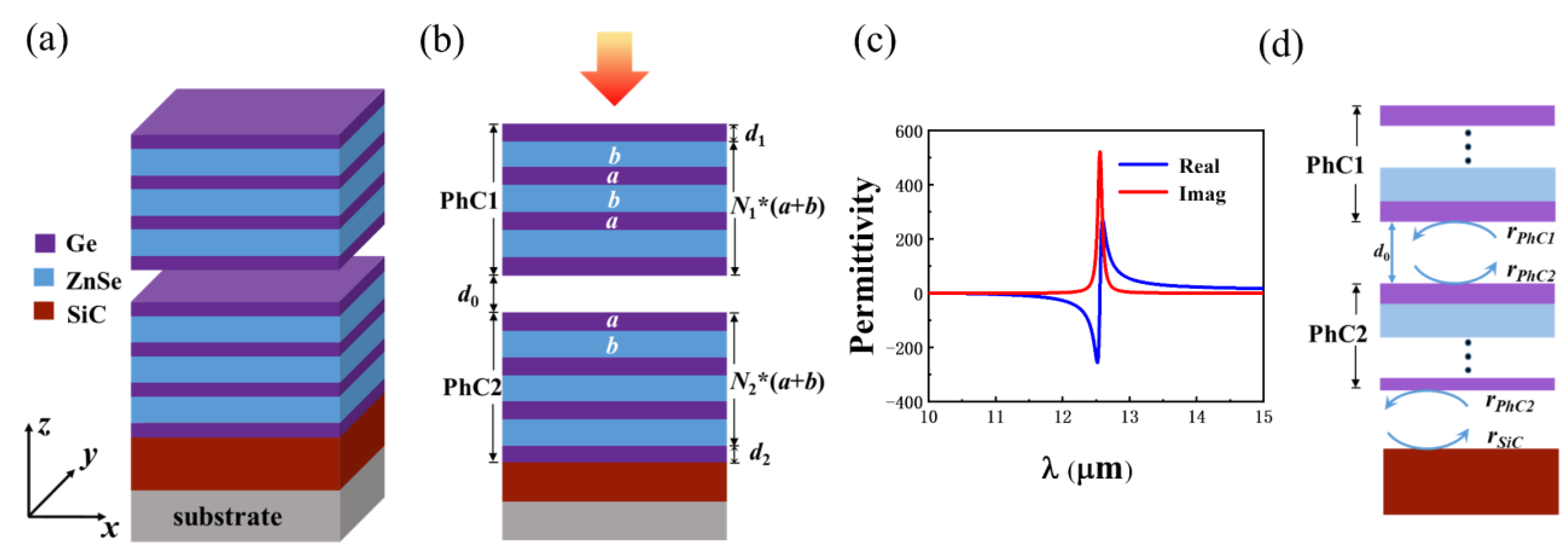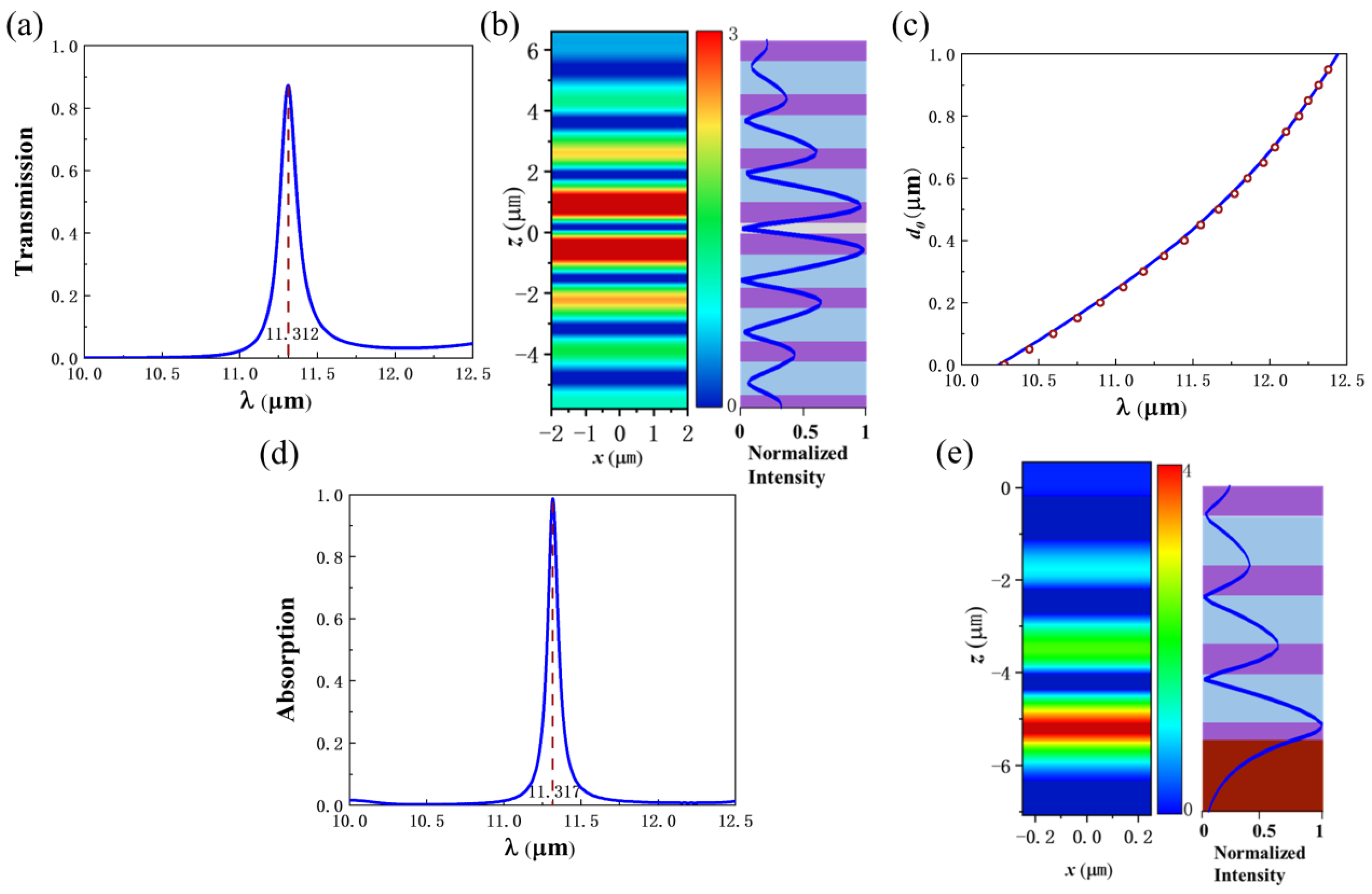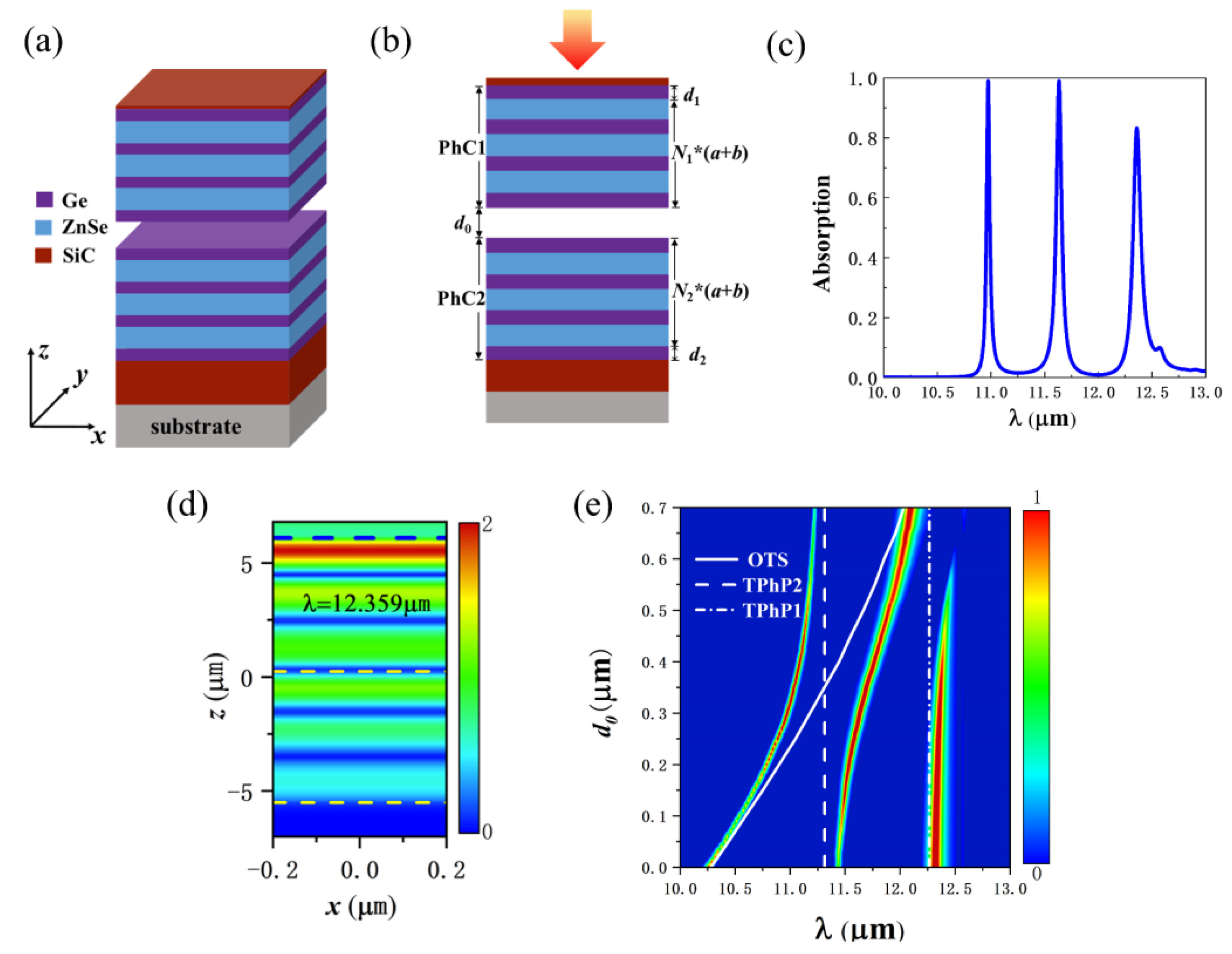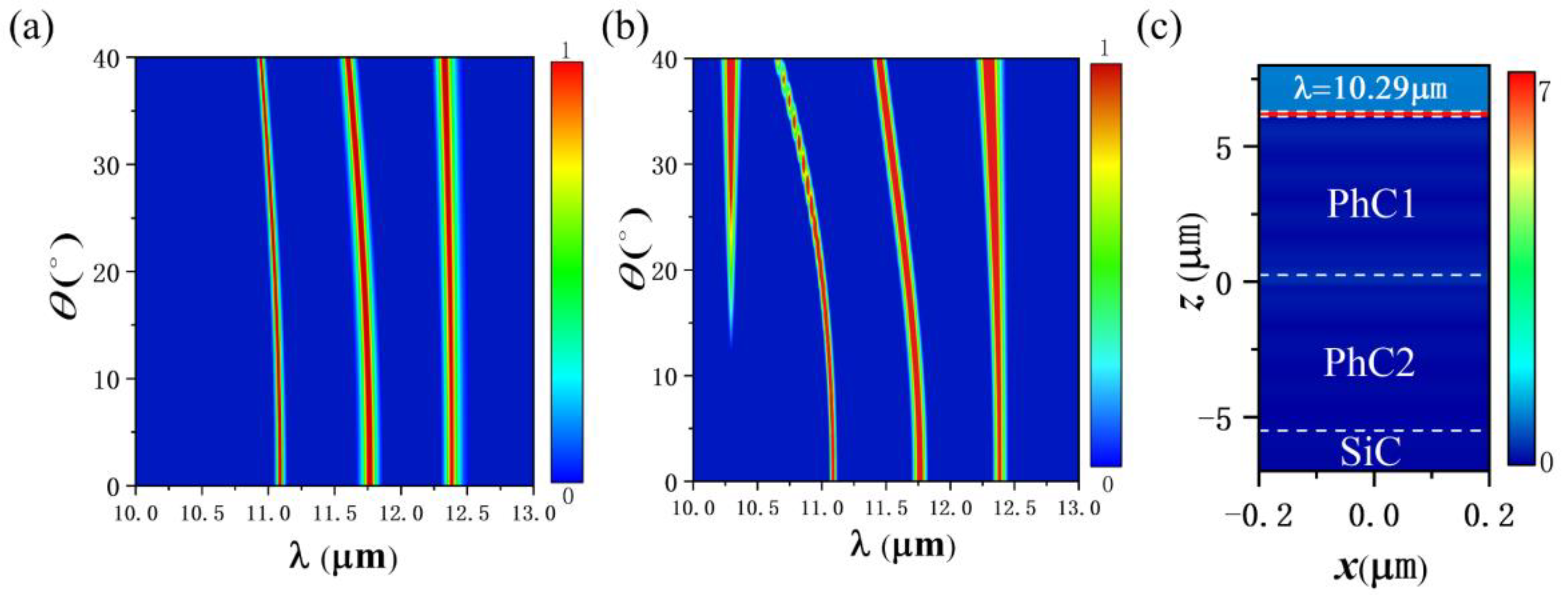Multi-Channel High-Performance Absorber Based on SiC-Photonic Crystal Heterostructure-SiC Structure
Abstract
:1. Introduction
2. Structure and Theory
3. Results and Analysis
3.1. Exciting of OTS and TPhP Modes
3.2. Coupling of OTS and TPhP Modes
3.3. Multi-Channel Adjustable Absorber
3.4. Influence of Incident Angle on Absorption Spectrum
4. Conclusions
Author Contributions
Funding
Institutional Review Board Statement
Informed Consent Statement
Data Availability Statement
Conflicts of Interest
References
- Liu, N.; Mesch, M.; Weiss, T.; Hentschel, M.; Giessen, H. Infrared Perfect Absorber and Its Application as Plasmonic Sensor. Nano Lett. 2010, 10, 2342–2348. [Google Scholar] [CrossRef]
- Wang, L.; Zhang, Y.; Wang, B.; Wei, Y.; Zhang, B.; Meng, L.; Liu, T.; Wang, B.; Han, B.; Jiang, Z.; et al. High-performance infrared Ge-based plasmonic photodetector enhanced by dual absorption mechanism. APL Photonics 2020, 5, 096104. [Google Scholar] [CrossRef]
- Wang, Z.; Clark, J.K.; Ho, Y.-L.; Volz, S.; Daiguji, H.; Delaunay, J.-J. Ultranarrow and Wavelength-Tunable Thermal Emission in a Hybrid Metal–Optical Tamm State Structure. ACS Photonics 2020, 7, 1569–1576. [Google Scholar] [CrossRef]
- Tittl, A.; Michel, A.-K.U.; Schaferling, M.; Yin, X.; Gholipour, B.; Cui, L.; Wuttig, M.; Taubner, T.; Neubrech, F.; Giessen, H. A Switchable Mid-Infrared Plasmonic Perfect Absorber with Multispectral Thermal Imaging Capability. Adv. Mater. 2015, 27, 4597–4603. [Google Scholar] [CrossRef]
- Shen, X.; Yang, Y.; Zang, Y.; Gu, J.; Han, J.; Zhang, W.; Cui, T.J. Triple-band terahertz metamaterial absorber: Design, experiment, and physical interpretation. Appl. Phys. Lett. 2012, 101, 154102. [Google Scholar] [CrossRef]
- Zheng, H.Y.; Jin, X.R.; Park, J.W.; Lu, Y.H.; Rhee, J.Y.; Jang, W.H.; Cheong, H.; Lee, Y.P. Tunable dual-band perfect absorbers based on extraordinary optical transmission and Fabry-Perot cavity resonance. Opt. Express 2012, 20, 24002–24009. [Google Scholar] [CrossRef] [PubMed]
- Wang, Z.; Hou, Y. Ultra-multiband absorption enhancement of graphene in a metal-dielectric-graphene sandwich structure covering terahertz to mid-infrared regime. Opt. Express 2017, 25, 19185–19194. [Google Scholar] [CrossRef] [PubMed]
- Hamidi, S.M.; Behjati, S. Large area multi-channel plasmonic absorber based on the touching triangular dimers fabricated by angle controlled colloidal nanolithography. Opt. Laser Technol. 2018, 99, 203–213. [Google Scholar] [CrossRef]
- Wu, J.; Liang, Y.; Guo, J.; Jiang, L.; Dai, X.; Xiang, Y. Tunable and Multichannel Terahertz Perfect Absorber Due to Tamm Plasmons with Topological Insulators. Plasmonics 2020, 15, 83–91. [Google Scholar] [CrossRef]
- Kavokin, A.V.; Shelykh, I.A.; Malpuech, G. Lossless interface modes at the boundary between two periodic dielectric structures. Phys. Rev. B 2005, 72, 233102. [Google Scholar] [CrossRef] [Green Version]
- Kaliteevski, M.; Iorsh, I.; Brand, S.; Abram, R.A.; Chamberlain, J.M.; Kavokin, A.V.; Shelykh, I.A. Tamm plasmon-polaritons: Possible electromagnetic states at the interface of a metal and a dielectric Bragg mirror. Phys. Rev. B 2007, 76, 165415. [Google Scholar] [CrossRef] [Green Version]
- Glukhov, I.A.; Dadoenkova, Y.S.; Bentivegna, F.F.L.; Moiseev, S.G. Deterministic aperiodic photonic crystal with a 2D array of metallic nanoparticles as polarization-sensitive dichroic filter. J. Appl. Phys. 2020, 128, 053101. [Google Scholar] [CrossRef]
- Wang, X.; Liang, Y.; Wu, L.; Guo, J.; Dai, X.; Xiang, Y. Multi-channel perfect absorber based on a one-dimensional topological photonic crystal heterostructure with graphene. Opt. Lett. 2018, 43, 4256–4259. [Google Scholar] [CrossRef] [PubMed]
- Gao, H.; Li, P.; Yang, S. Tunable multichannel optical absorber based on coupling effects of optical Tamm states in metal-photonic crystal heterostructure-metal structure. Opt. Commun. 2020, 457, 124688. [Google Scholar] [CrossRef]
- Folland, T.G.; Nordin, L.; Wasserman, D.; Caldwell, J.D. Probing polaritons in the mid- to far-infrared. J. Appl. Phys. 2019, 125, 191102. [Google Scholar] [CrossRef]
- Feng, K.; Streyer, W.; Zhong, Y.; Hoffman, A.J.; Wasserman, D. Photonic materials, structures and devices for Reststrahlen optics. Opt. Express 2015, 23, A1418–A1433. [Google Scholar] [CrossRef]
- Juneau-Fecteau, A.; Savin, R.; Boucherif, A.; Fréchette, L.G. Tamm phonon-polaritons: Localized states from phonon-light interactions. Appl. Phys. Lett. 2019, 114, 141101. [Google Scholar] [CrossRef]
- Gao, W.; Hu, X.; Li, C.; Yang, J.; Chai, Z.; Xie, J.; Gong, Q. Fano-resonance in one-dimensional topological photonic crystal heterostructure. Opt. Express 2018, 26, 8634–8644. [Google Scholar] [CrossRef]
- Hu, J.; Liu, W.; Xie, W.; Zhang, W.; Yao, E.; Zhang, Y.; Zhan, Q. Strong coupling of optical interface modes in a 1D topological photonic crystal heterostructure/Ag hybrid system. Opt. Lett. 2019, 44, 5642–5645. [Google Scholar] [CrossRef]
- Wang, Z.; Ho, Y.-L.; Cao, T.; Yatsui, T.; Delaunay, J.-J. High-Q and Tailorable Fano Resonances in a One-Dimensional Metal-Optical Tamm State Structure: From a Narrowband Perfect Absorber to a Narrowband Perfect Reflector. Adv. Funct. Mater. 2021, 31, 2102183. [Google Scholar] [CrossRef]
- Qing, Y.M.; Ma, H.F.; Wu, L.W.; Cui, T.J. Manipulating the light-matter interaction in a topological photonic crystal heterostructure. Opt. Express 2020, 28, 34904–34915. [Google Scholar] [CrossRef] [PubMed]
- Peng, B.; Özdemir, Ş.K.; Chen, W.; Nori, F.; Yang, L. What is and what is not electromagnetically induced transparency in whispering-gallery microcavities. Nat. Commun. 2014, 5, 5082. [Google Scholar] [CrossRef] [PubMed]
- Palik, E.D.; Ghosh, G.; Prucha, E.J. Handbook of Optical Constants of Solids; Academic Press: Orlando, FL, USA, 1998. [Google Scholar]
- Connolly, J.; Dibenedetto, B.; Donadio, R. Specifications of Raytran Material. In Proceedings of the Contemporary Optical Systems and Components Specifications, Washington, DC, USA, 17–20 April 1979. [Google Scholar]
- Li, K.; Fitzgerald, J.M.; Xiao, X.; Caldwell, J.D.; Zhang, C.; Maier, S.A.; Li, X.; Giannini, V. Graphene Plasmon Cavities Made with Silicon Carbide. ACS Omega 2017, 2, 3640–3646. [Google Scholar] [CrossRef]
- Novotny, L. Strong coupling, energy splitting, and level crossings: A classical perspective. Am. J. Phys. 2010, 78, 1199–1202. [Google Scholar] [CrossRef] [Green Version]
- Törmä, P.; Barnes, W.L. Strong coupling between surface plasmon polaritons and emitters: A review. Rep. Prog. Phys. 2015, 78, 013901. [Google Scholar] [CrossRef]
- Agranovich, V.M.; Litinskaia, M.; Lidzey, D.G. Cavity polaritons in microcavities containing disordered organic semiconductors. Phys. Rev. B 2003, 67, 085311. [Google Scholar] [CrossRef]
- Salomon, A.; Gordon, R.J.; Prior, Y.; Seideman, T.; Sukharev, M. Strong Coupling between Molecular Excited States and Surface Plasmon Modes of a Slit Array in a Thin Metal Film. Phys. Rev. Lett. 2012, 109, 073002. [Google Scholar] [CrossRef] [PubMed] [Green Version]
- Ruppin, R.; Englman, R. Optical phonons of small crystals. Rep. Prog. Phys. 1970, 33, 149. [Google Scholar] [CrossRef]
- Englman, R.; Ruppin, R. Optical Lattice Vibrations in Finite Ionic Crystals: I. J. Phys. C 1968, 1, 614. [Google Scholar] [CrossRef]
- Fuchs, R.; Kliewer, K.L. Optical Modes of Vibration in an Ionic Crystal Slab. Phys. Rev. 1965, 140, A2076. [Google Scholar] [CrossRef]
- Passler, N.C.; Gubbin, C.R.; Folland, T.G.; Razdolski, I.; Katzer, D.S.; Storm, D.F.; Wolf, M.; de Liberato, S.; Caldwell, J.D.; Paarmann, A. Strong Coupling of Epsilon-Near-Zero Phonon Polaritons in Polar Dielectric Heterostructures. Nano Lett. 2018, 18, 4285–4292. [Google Scholar] [CrossRef] [Green Version]





Publisher’s Note: MDPI stays neutral with regard to jurisdictional claims in published maps and institutional affiliations. |
© 2022 by the authors. Licensee MDPI, Basel, Switzerland. This article is an open access article distributed under the terms and conditions of the Creative Commons Attribution (CC BY) license (https://creativecommons.org/licenses/by/4.0/).
Share and Cite
Han, J.; Jiang, J.; Wu, T.; Gao, Y.; Gao, Y. Multi-Channel High-Performance Absorber Based on SiC-Photonic Crystal Heterostructure-SiC Structure. Nanomaterials 2022, 12, 289. https://doi.org/10.3390/nano12020289
Han J, Jiang J, Wu T, Gao Y, Gao Y. Multi-Channel High-Performance Absorber Based on SiC-Photonic Crystal Heterostructure-SiC Structure. Nanomaterials. 2022; 12(2):289. https://doi.org/10.3390/nano12020289
Chicago/Turabian StyleHan, Jing, Jijuan Jiang, Tong Wu, Yang Gao, and Yachen Gao. 2022. "Multi-Channel High-Performance Absorber Based on SiC-Photonic Crystal Heterostructure-SiC Structure" Nanomaterials 12, no. 2: 289. https://doi.org/10.3390/nano12020289
APA StyleHan, J., Jiang, J., Wu, T., Gao, Y., & Gao, Y. (2022). Multi-Channel High-Performance Absorber Based on SiC-Photonic Crystal Heterostructure-SiC Structure. Nanomaterials, 12(2), 289. https://doi.org/10.3390/nano12020289





